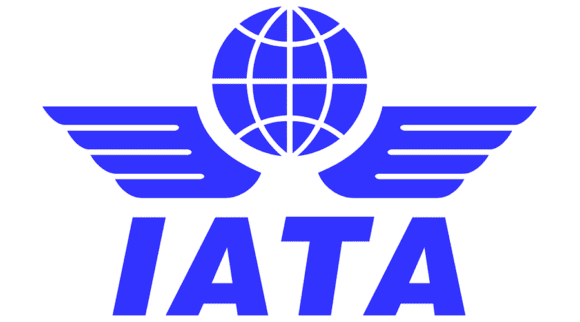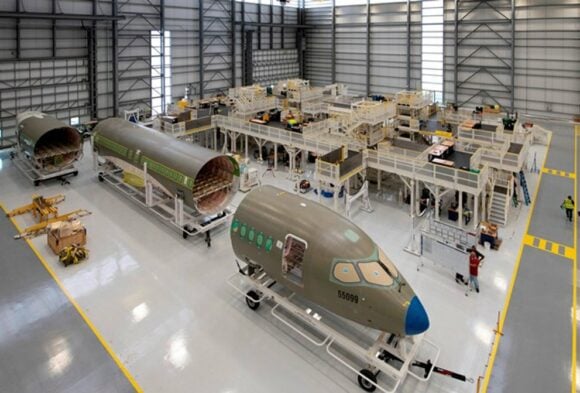
Energia Family 2022 Formation Flight 04 scaled
Embraer has identified a hybrid and a hydrogen fuel cell aircraft as the most promising two concepts that it wishes to further develop as part of its Energia project. The two aircraft could be available in the first half of the next decade. Two other concepts will be parked for now, but could be used at a later stage, the Brazilian airframer said on December 5. Embraer downselects Energia to Hybrid and H2 fuel cell concepts.
Almost thirteen months ago on November 8, 2021, Embraer unveiled four concepts of the Energia program, its view on sustainable, net-zero, and zero-emission aviation for 2050. The concepts included the Energia Hybrid, a nine-seater with electric motors but a single-piston engine in the back, plus the Energia Electric, a full-electric nine-seater. The third concept was the Energia H2 Hydrogen Fuel Cell, a 19-seater using fuel cells to convert hydrogen into electricity. The fourth was the Energia H2 Gas Turbine, a 35-50 seater with two gas turbines that used hydrogen on short flights and sustainable aviation fuel (SAF) on longer flights.
Since the unveiling, Embraer has further done its homework, both on the technical front and on market research. It worked together with airlines and existing and start-up engine OEMs on their preferences and joint studies. Senior Vice President of Engineering, Luis Carlos Affonso, said that Embraer studied more than twenty concepts, but it has now downselected this to two concepts, both with rear-mounted engines, a T-tail, and efficient, clean wings.
“Our journey to a fully sustainable aircraft fleet will likely start with smaller commuter and regional aircraft, which by the specific mission characteristics may be developed earlier, delivering a truly sustainable solution. This will allow the scaling up and infusion of lower and zero carbon architectures on bigger aircraft in the future while still offering a viable solution for shorter-haul flights of today”, Affonso said. For this, Embraer is using the mantra “the mission is defining the architecture.”
The Energia Hybrid has grown to a 19 and 30-seater. (Embraer)
Energia Hybrid
The Energia Hybrid is the first. From a nine-seater in 2021, Embraer has grown the concept to actually two models: the 19-seater E19-HE and the 30-seater E30-HE. They use next-generation cruise-optimized thermal gas turbine engines that run on SAF to help reduce carbon emissions by ninety percent.
The hybrid-electric part seems to be only a very mild form of hybridization, as the electric motors act as a booster in certain phases of flight like taxiing, take-off, and climb. The Hybrid should have a range of at least 500 nautical miles/926 kilometers. The airframer says this concept should reach technological readiness around 2030.
The H2 Fuel Cell has also grown since the unveiling of the first concept in 2021. Note the inlet in front of the tail fin to feed cool air into the heat exchangers. (Embraer)
Energia H2 Fuel Cell
The bigger Energia H2 Fuel Cell concept is planned as the 19-seater E19-H2FC, but Embraer is also exploring a stretch as a 30-seater to make it the E30-H2FC which should have better economics than the smaller one. It solely uses hydrogen fuel cell technology, with the fuel cells integrated into the empennage of the aircraft. The close proximity to the rear-mounted electric turboprop motors simplifies the installation of the propulsion system.
An inlet in front of the vertical tail feeds ram air into the heat exchangers of the fuel cells to optimize thermal efficiency, which is crucial in hydrogen and hybrid-electric aircraft. The two versions should have a range of 200nm/370km and could be available in 2035, but more studies will be done in 2023 to explore the advantages and consideration of a hydrogen propulsion system in a 30-seater.
Cabin
During its live stream event from Sao Jose dos Campos and Amsterdam, Embraer showed computer renderings of the cabin. The two aircraft share a 2+1 seat configuration in a spacious cabin with renewable materials that leans on concepts that are familiar from the E-Jets and executive jets.
Computer rendering of cabin of the 19-seater aircraft. (Embraer)
The rear-mounted engines and propellers also help to reduce cabin noise. Affonso said that the focus shifted quite early this year to a 19-seat version as the smallest one, with the 30-seat the bigger version. “The 19 to 30-seaters are sensible starting points for follow-up studies since they are likely to present earlier technical and economical readiness. After these assessments are more advanced, we will start exploring larger aircraft sitting around fifty passengers”, said Affonso, who added that a family approach is a key consideration.
Embraer didn’t explain more why it has chosen to grow the size of the aircraft, but it is interesting to note Heart Aerospace recently decided to grow its full-electric 19-seater into a hybrid-electric 30-seater as well after potential airline customers said that the original version would be too small.
Advisory Board
Earlier this year, the Brazilian OEM established an Energia Advisory Board, which has now over twenty airlines onboard to exchange views and concepts. In the coming months, Embraer will present the concepts to the Board and have more discussions with airlines. The first response has been positive, as customers see “a solid path from Embraer to bring the concepts to life”, said Vice President of Marketing, Rodrigo Silva e Souza.
Although not as extensively done as its annual market forecast, Embraer has explored the potential market demand for the Energia models. Silva e Souza said that a conventional scenario of substitution and natural growth sees demand for 4.000 aircraft until 2035. If accelerated retirement of older-generation small aircraft is considered, the market could grow to 7.000.
In its ‘Revolution future’ scenario that includes new demand, the market could be as big as 20.000 aircraft in 2035. In all scenarios, Silva e Souza admitted that there is some overlap with the 50-seater market from its global market forecast, but otherwise, these numbers add to the 10.950 regional (150-seat) aircraft that Embraer is projecting until 2041. Interestingly, Silva e Souza said that right now, Embraer doesn’t know which type of operator will be adopting the Energia-type of aircraft: “Will it be current regional operators, charter operators or a new type of operator? We still don’t know, but we see the potential.” He added that getting the electric and hydrogen infrastructure in place is of course crucial to the success of this new technology, something that is a concern for Airbus too as Guillaume Faury said last week during the Airbus Summit.
“We see that with the new technology, there is a potential for significant cost reductions. There is also a different appeal because of the sustainability element. This can really attract more passengers and operators”, said Silva e Souza. He showed a graphic that compared trip costs and time of an electric vehicle with that of the 30-seat fuel cell aircraft, claiming that over a 200-300nm trip, the aircraft would be $45 cheaper than the car, travel twice as fast, and produce 25 percent fewer emissions.
Embraer has not given up on the Electric and H2 Gas Turbine concepts. Electric battery technology will, of course, find its way on the Eve eVTOL. The gas turbine concept with direct hydrogen burn would be more efficient on a 100-seater. “But in the middle, where our Energia concepts are, the gas turbine is not very efficient and the full-electric concept is too heavy. For this space, the hybrid-electric and the hydrogen fuel cell are ideal”, said Luis Carlos Affonso.
Views: 32







